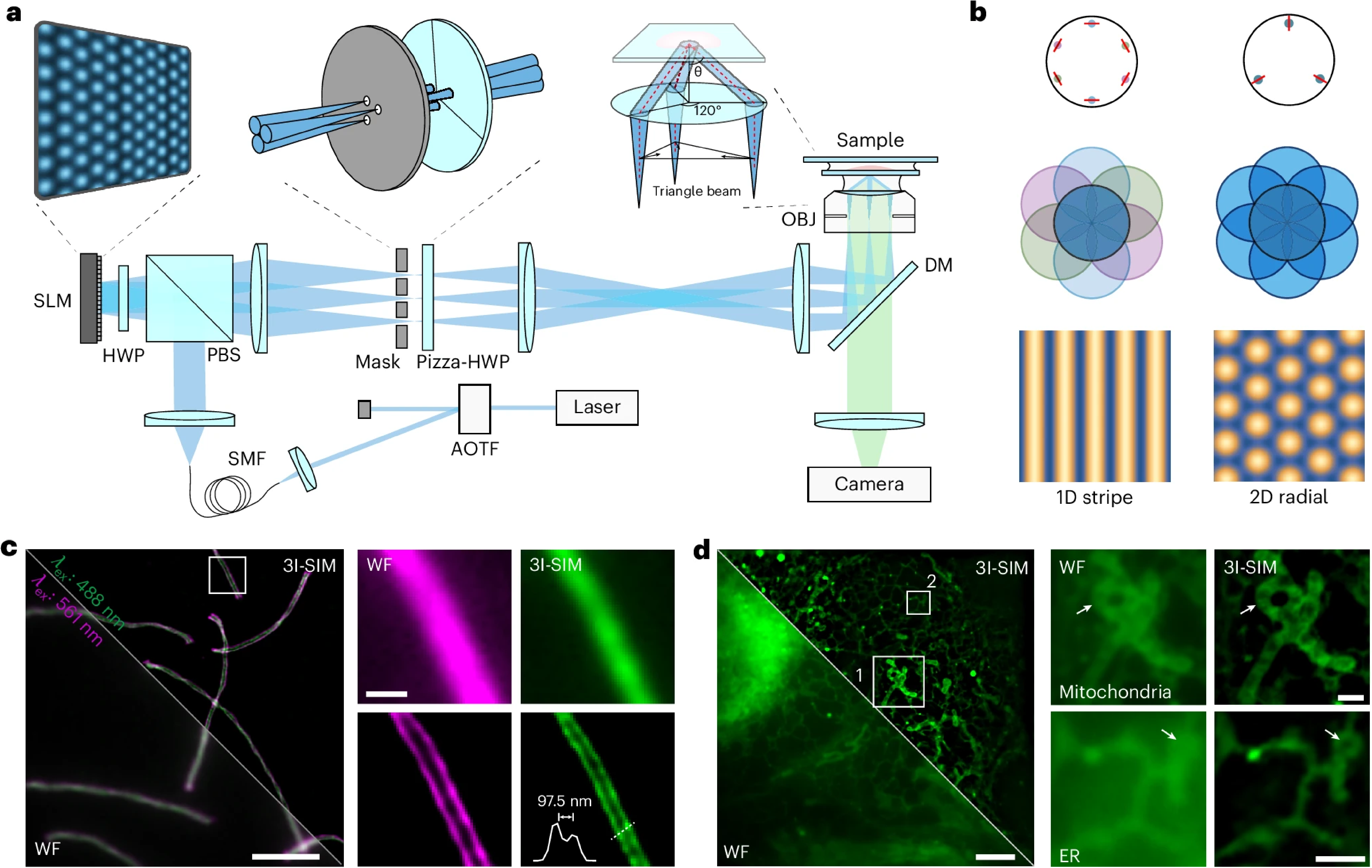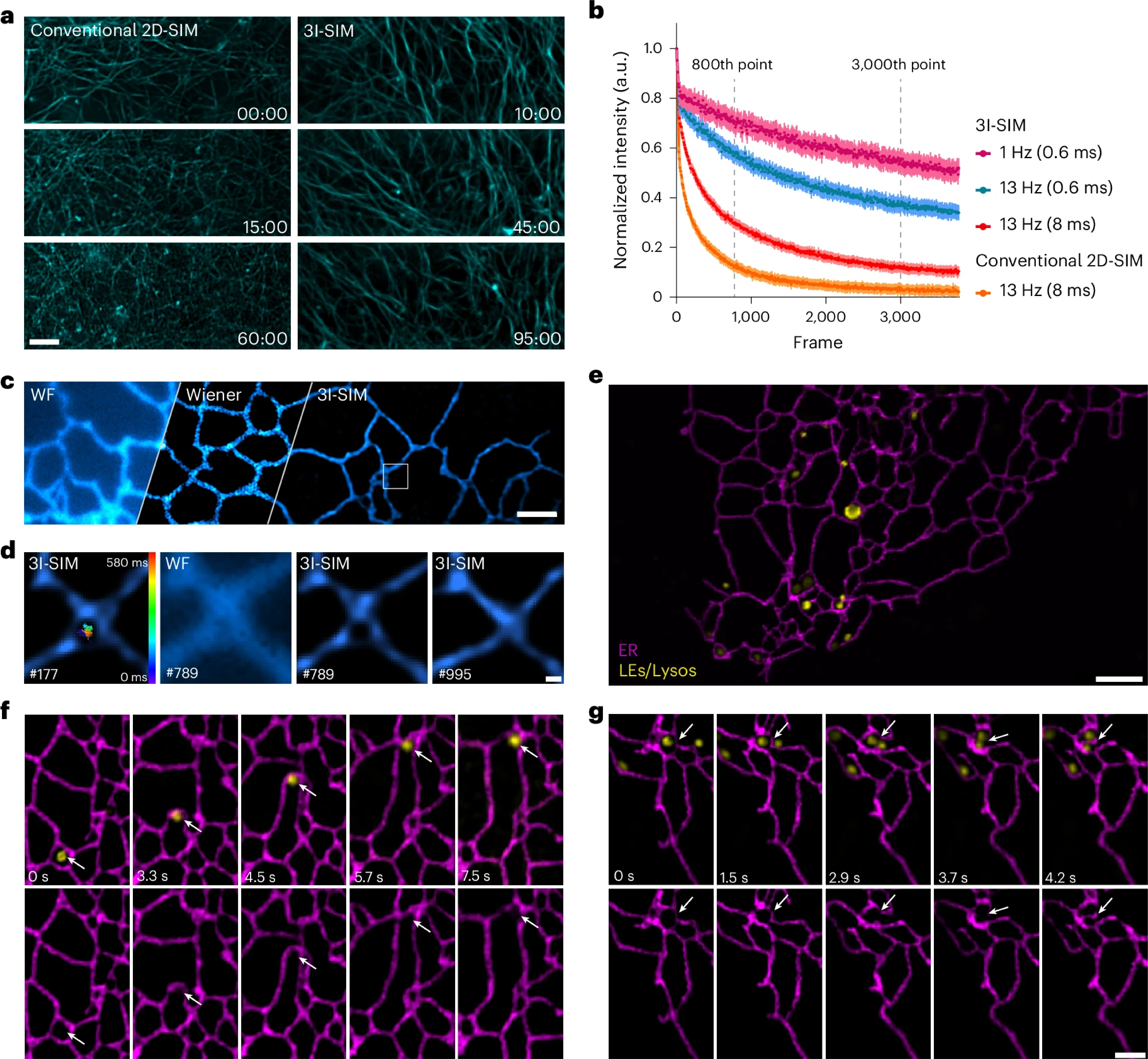Peking University, Aug 18, 2025: Professor Xi Peng’s team from the College of Future Technology at Peking University has recently developed a triangle structured illumination microscopy (SIM), which enables gentler, sustained super-resolution live-cell imaging. This study was published in
Nature Photonics with the title “Triangle-beam interference structured illumination microscopy.” This novel method upgrades the super-resolution imaging to an unprecedented kilo-Hz speed and half-day-long duration, providing possibilities to study complex and rapid biological processes with higher data throughput.
Background
SIM is the most preferable super-resolution imaging system for live-cell super-resolution imaging. It enables the observation of intricate subcellular dynamics, motivating many new biological discoveries. However, conventional SIM has long relied on the complex rotation of one-dimensional stripe illumination at three angles, requiring nine exposures to reconstruct a uniform super-resolution image. This greatly hinders the imaging speed and causes unnecessary photobleaching, limiting the available information flux in live-cell imaging.
Why it matters
Many cellular activities occur at an intrinsic duration or rather long time scale and are hard to observe now. It relies on the advancement of the imaging technique. While the current SIM already achieves several-hour-long duration and ~500 Hz speed, it still fails to meet the requirements for some cell biology studies. A faster, more sustained SIM system represents a significant advancement in capturing these dynamics.

Figure 1. Principle and performance characterization of 3I-SIM. a. Schematic of the 3I-SIM imaging system. b. Comparison of conventional two-beam interference modulation and 3I-SIM triangular-beam interference modulation patterns. c. Dual-color imaging of synaptonemal complexes, comparing widefield and super-resolution results. d. Imaging of Nile Red–labeled COS-7 cells, comparing widefield and super-resolution results.
Key improvements
Drawing inspiration from the simplicity and efficiency of triangular structures, this study innovatively employs triangular-beam interference to achieve 2D lattice modulation, expanding high-frequency spatial information in both dimensions in a single exposure. While conventional 2D-SIM requires multiple 1D modulation at different angles, the 3I-SIM generates a 2D hexagonal lattice illumination with 3-beam interference. With only 7 raw frames shifting in 1D required, 3I-SIM effectively mitigates photobleaching during acquisition and improves the speed by 3-fold through minimizing redundant spatial sampling and continuous rolling reconstruction. As a result, 3I-SIM achieves an imaging speed of up to 1,697 Hz under single-frame rolling reconstruction, and enables up to 13-hour-long super-resolution imaging with over 100,000 recording time points.
The breakthrough of 3I-SIM has enabled the study of organelle activities that are unreachable with previous techniques. Using 3I-SIM, the research team records fine morphological changes in neuronal growth cones for up to 13 hours, as well as the transient signals from actin structures regulating endoplasmic reticulum dynamics.

Figure 2. 3I-SIM enables faster and gentler live-cell organelle imaging. a, b. Comparison of photobleaching on fluorescent proteins under different illumination modes and excitation strategies between conventional 2D-SIM and 3I-SIM. c, d. Dynamic ER imaging at 1,697 Hz, with magnified details and trajectories of ER ring closure events. e–g. Interactions between LEs/Lysos and ER, including local deformations during rapid movement and coordinated ER tubule remodeling during "kiss-and-run" events.
The 3I-SIM system can be flexibly upgraded on common 2D-SIM platforms, effectively lowering the technical barrier and enabling more research teams to access next-generation live-cell super-resolution imaging.
*This article is featured in PKU News "Why It Matters" series. More from this series.
Read more: https://doi.org/10.1038/s41566-025-01730-0
Source: College of Future Technology, Peking University
Edited by: Chen Shizhuo

